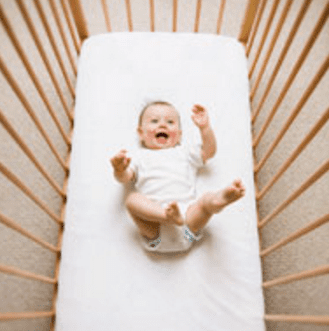Buying The Right Crib For Baby
Babies sleep so much, especially their first year, that your beloved little lamb will actually spend more time in her crib or play yard than she does in your arms so it’s most important that you are buying the right crib for baby.
With more than 9 million cribs, bassinets and play yards recalled since 2007, and new crib manufacturing standards just developed, you should know it’s possible to buy and use safe sleeping surfaces for your baby if you follow expert advice.
Statistics show more than 30 infant deaths and hundreds of injuries related to defective or misused cribs since 2002. In late October, the Consumer Product Safety Commission (CPSC) announced a “Sleep Safe” campaign designed to help educate parents on crib and sleep safety. “Nurses will not allow newborn babies to leave the hospital without parents having a safe car seat. I also believe that we need to make sure that new parents provide a safe crib, bassinet or play yard for their babies to sleep in,” said CPSC Chairman Inez Tenenbaum.
SEE ALSO: Sudden Infant Death Syndrome and The Car Seat Challenge
To ensure your baby’s nursery is the safest room in the house follow these CPSC and other expert-suggested guidelines:
Buy a Safe Crib
Whether your baby will snooze in a crib, bassinet or play yard (many families use all 3!), these tips from the CPSC and other experts will help you buy the safest possible sleep sanctuary:
1 Buy a new crib manufactured to the latest safety standards (most, if not all drop-side crib styles have now been recalled); quality materials and hardware are more important than price. Compare models in a baby store and shake them to see if they wobble or give. Make sure there are no cut-outs where clothes or limbs can get caught. Your baby can strangle to death if her body passes through any gaps between loose components or broken slats while her head remains entrapped.
2 Register your crib as soon as you buy it with the manufacturer to receive any recall notices or parts updates.
3 Avoid used cribs: While experts strongly recommend against re-using a crib, if you must re-use a crib from another sibling or buy a used one, make sure it was manufactured no more than 10 years ago, that it has all original crib hardware and parts, and complete instructions. Never buy a crib that’s missing the sticker with its manufacturing date and serial number. You should still register the crib with the manufacturer to receive future recall notices.
4 Assemble the crib or bassinet/play yard exactly as instructed. Failure to assemble or use the crib properly is the #1 cause of infant injuries or deaths in sleep areas. Install each part exactly as directed; if unsure, call the manufacturer’s installation number provided with the instructions.
5 Mesh-sided bassinets or play pens should have mesh less than ¼ inch in size (smaller than the tiny buttons on your baby’s clothes) with no tears, holes or loose threads to entangle her; mesh should be securely attached to all top rails and the floor plates with no missing, loose or exposed staples.
6 Buy the right mattress size: You should be able to squeeze no more than 2 fingers-width between the mattress and the sides of the crib or bassinet; a tighter fit reduces entrapment risks. The crib’s instructions will give you the size mattress specifically designed to fit. Use only the manufacturer-supplied sleeping pad for your bassinet or play yard and do not add any padding to these sleep surfaces.
7 Buy the right sheets: Only use sheets designed for your mattress or bassinet/play yard. They must be secure, tucked-under on all sides and should not come loose as baby lays or rolls on them.
Avoid entanglements:
Never place your baby’s sleep center near a window with blinds, roman shades, curtains or baby monitor cords; babies can strangle on cords or become entrapped in window treatments. If you want to mount a monitor near your baby, place it on a shelf or piece of furniture away from the crib or sleeping surface, and enclose the cord in wire molding (available at hardware stores) so that baby can never pull the cord into her area
After reading ‘Buying The Right Crib For Baby’, do also read our Breastfeeding and Newborn Care sections for many more articles on the care of your baby. Another good section to stop by at is Safety & Childproofing plus do have a look at our Diapering section that is sponsored by Huggies.
RELATED TOPICS:
Caregivers & Your Baby’s Safe Sleep
Crib Safety: Safer Sleep for Babies
Keep Your Baby Close While Sleeping
RELATED VIDEOS:
What is the Best Way to Swaddle My Baby?







Comments are closed.